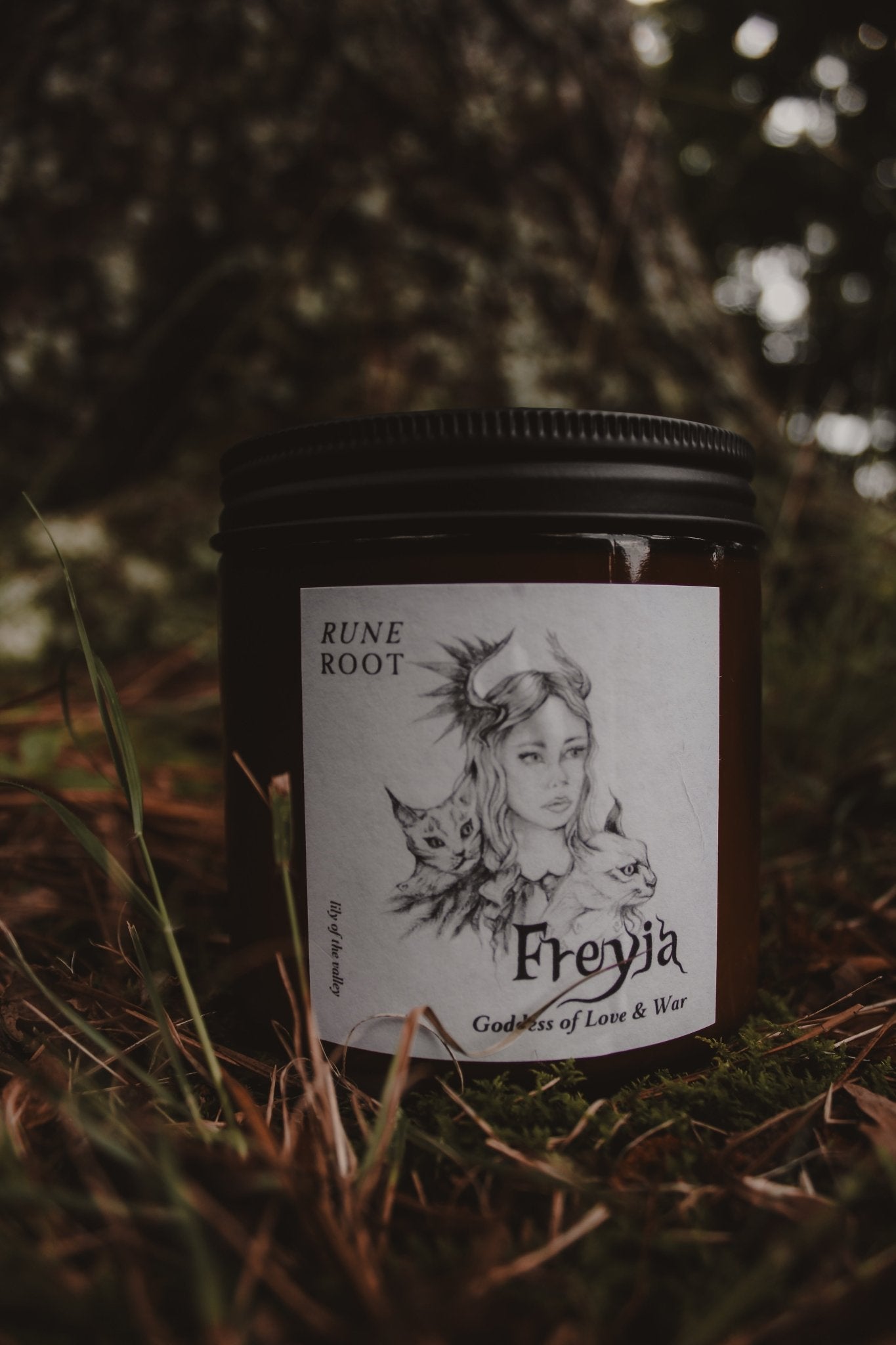The Powerful Symbolism of Freya, Norse Goddess of Love & War
The whispers of her name echo through time – Freya, or Freyja in the Old Norse spelling. A goddess whose essence twines with the wild heart of existence, embracing the cyclical dance of love and loss, beauty and brutality, life and death. Within the ancient Norse cosmology, where gods mirrored the raw forces of nature, Freyja reigns as a complex and compelling deity. The Eddas, those fragmented echoes of a vibrant oral tradition, offer glimpses into her multifaceted nature. She is Freyja, "The Lady," and her story calls to something ancient and primal within us, beckoning us to reconnect with the raw, untamed currents that pulse beneath the surface of our modern world.
Freya: Goddess of Love, Beauty, War, and Death
Freya is a study in captivating contradictions: a goddess of intoxicating love and fierce battle prowess, a weaver of potent magic and a seeker of pleasures both earthly and divine. She is the embodiment of untamed beauty, a force of nature as wild and unpredictable as the seas, yet as nurturing and life-giving as the earth itself. Her myths weave a tapestry of longing and liberation, inviting us to explore the raw edges of our own beings, where shadow and light dance in an eternal, intoxicating embrace.
Freya's Symbolism
Freya is often portrayed as a goddess of love, beauty, and sensuality. While these attributes hold undeniable truth, they represent only a single facet of her being. To limit Freya to these concepts is to miss the untamed heart that beats at her core. She is a goddess of contrasts and contradictions, as comfortable on the battlefield as she is within sacred groves.
Her lineage speaks to this duality. Born of the Vanir, a tribe of gods associated with fertility, magic, and the untamed power of nature, Freya embodies a wildness that defies easy categorization. Yet, she is also embraced by the Aesir, the gods of war and social order, highlighting her ability to navigate and bridge seemingly opposing realms.
Picture Freya, hair like spun gold, eyes reflecting the wisdom of ages, riding her chariot across the sky. But these are no ordinary steeds that pull her chariot – they are cats, creatures revered for their duality. Cats embody a fierce independence, their loyalty earned, not given freely. They walk between worlds, at home in the shadows as well as the hearth. They are hunters, their senses attuned to unseen realms, yet they offer purrs of contentment and seek out human companionship.
Freya’s choice of companions speaks volumes. She is a goddess who embraces paradox – strength and softness, ferocity and tenderness. Like the cats who attend her, she is a force to be reckoned with, yet capable of bestowing great love and affection.
In many depictions, Freya is adorned with feathers, a symbol of flight, freedom, and the ability to transcend earthly limitations. This resonates deeply with her mastery of seiðr, a potent form of Norse magic often associated with divination, shapeshifting, and manipulation of fate. Seiðr was not merely a practice for Freyja – it was an intrinsic part of her being. Through seiðr, she moved between realms, communed with spirits, and bent the threads of destiny to her will.
Her most prized possession, the legendary feather cloak, Valshamr, speaks to this deep connection with avian magic. Donning this cloak, Freya could transform into a falcon, soaring above the constraints of the physical world. This transformation echoes the cyclical journeys of the soul, shedding its earthly form to gain a higher perspective. Like the falcon who dives from great heights to snatch its prey, Freyja, cloaked in feathers, reminds us that true power lies in embracing both the seen and unseen, the earthbound and the ethereal realms that exist within and around us.
Gold. The mere mention of this precious metal evokes an aura of royalty, abundance, and enduring value. For Freya, however, gold holds a significance that transcends material wealth. It is a symbol of her inner radiance, the divine spark that shines even amidst the darkest of nights.
Remember the tears of gold that Freya weeps, each one a potent expression of her grief? These are not tears of weakness, but of a heart that feels deeply, a heart connected to the cyclical rhythms of life, death, and rebirth. Just as the sun rises and sets each day, Freya's sorrow gives way to joy, her losses ultimately fueling her capacity for love and creation.
Her legendary necklace, the Brisingamen, embodies this interplay of light and shadow, creation and destruction. Crafted by dwarves, masters of the earth's hidden treasures, the Brisingamen is said to be as radiant as the sun, its brilliance a manifestation of Freya’s own inner fire. Yet, the myths surrounding its acquisition hint at the complexities inherent in wielding such beauty and power. Some tales speak of sacrifices made, of boundaries crossed in the pursuit of such exquisite beauty. The Brisingamen, then, becomes a potent reminder that true power demands a recognition of our own depths, a willingness to embrace both the light and shadow within.
Freya's Connection to Modern Life

Caption: Freya (1890) by James Doyle Penrose. Public Domain. A late 19th-century interpretation of the Norse goddess, highlighting her allure and feminine power.
Centuries may have passed since the skalds sang of her exploits, yet Freya's presence remains as potent as ever, echoing in the depths of our collective unconscious. Her story is a call to reclaim the wild heart within, to embrace the fullness of our being – the fierce and the tender, the sensual and the spiritual.
Freya’s unwavering self-possession, her unabashed pursuit of pleasure and deep connection to the magical currents of life, stand in stark contrast to the constricted roles often imposed upon the feminine. She reminds us that sensuality is not a sin, but a sacred expression of our aliveness, a gateway to deeper wisdom and ecstatic communion with the world around us.
Like Freya, we too possess the power of seiðr, the ancient magic that flows through all living things. It whispers to us through intuition, dreams, and those moments of deep connection with the natural world. To cultivate this connection, we must create space for stillness, for listening to the whispers of our own hearts and the rhythms of the earth beneath our feet. Just as Freya embraces both the light and shadow within herself, we too must learn to honor the full spectrum of our being, acknowledging the cycles of creation and destruction that shape our lives.
Sensuality & Embodiment
Freya's unapologetic joy in pleasure and ownership of her desires are timeless inspirations. Her refusal to be shamed for her sensuality is inherently empowering. By celebrating her embodiment, Freya invites us to reclaim our own – not for the approval of others, but as an act of self-affirmation.
Seeking the Unknown, Magic Within
Freya's association with Norse magic, known as seiðr, speaks to a power beyond the physical. Seiðr, with its trance-like states and focus on prophecy, suggests an embrace of intuition and hidden knowledge. In a world with strict social structures, such practices offered a path to power often associated with the feminine. Modern interpretations cast seiðr as a way to connect with one's inner wisdom and unseen forces. Through Freya, we're reminded that true power lies not in external control, but in aligning with deeper truths within ourselves and the natural world.
Ritual Candle for Freya
Immerse yourself in a ritual of the senses with the intoxicating fragrance of pure Lily of the Valley. Verdant notes mingle with a subtle, seductive sweetness, creating a scent that lingers on the air – a captivating echo of Freya's enduring allure. Infused into a creamy blend of natural coconut and soy wax, this candle features a crackling wooden wick that adds a touch of ancient warmth, reminiscent of a sacred hearth.

